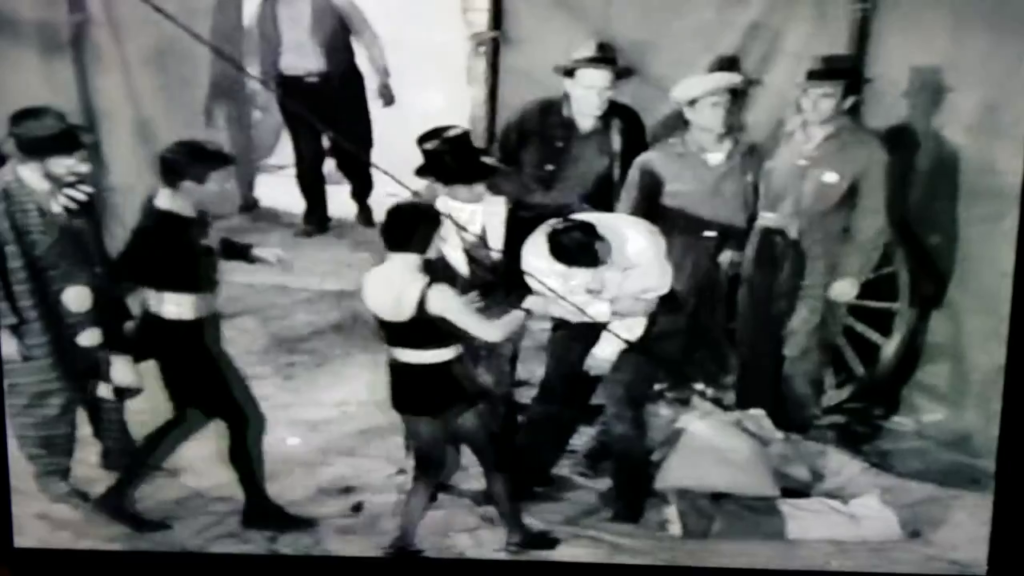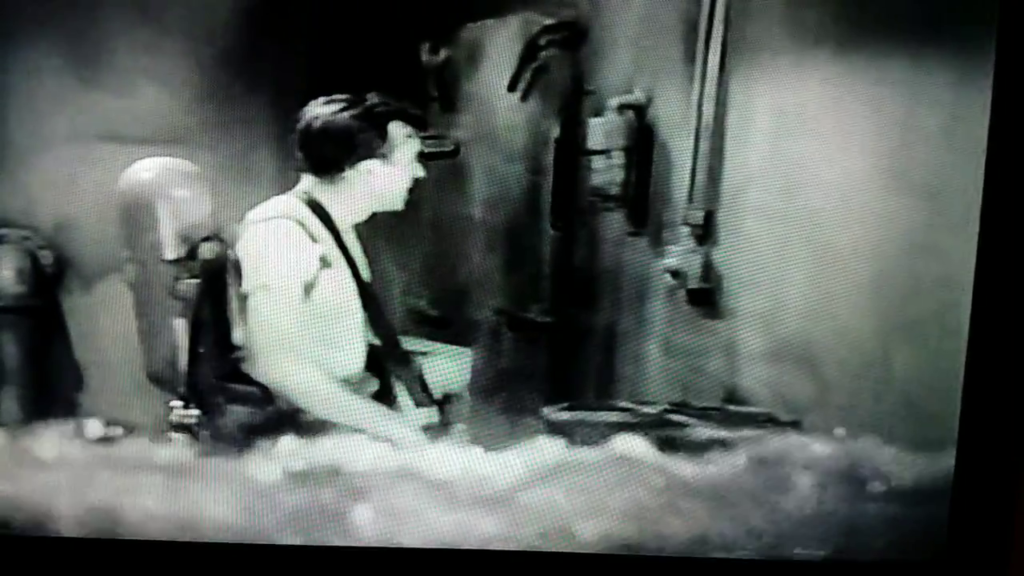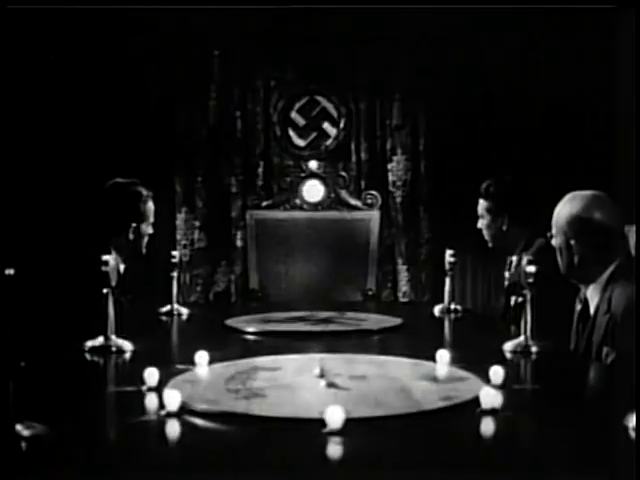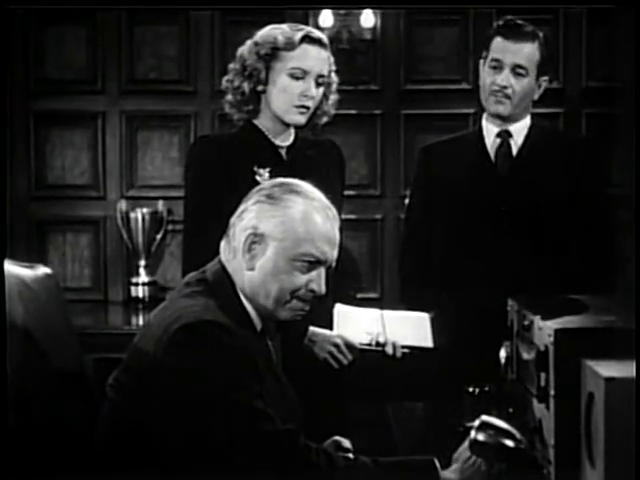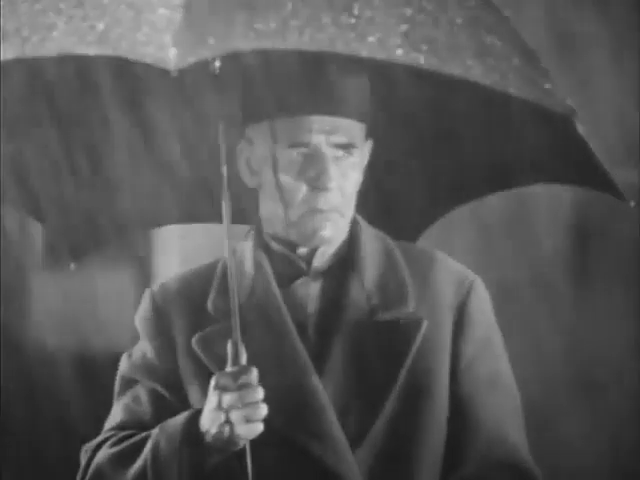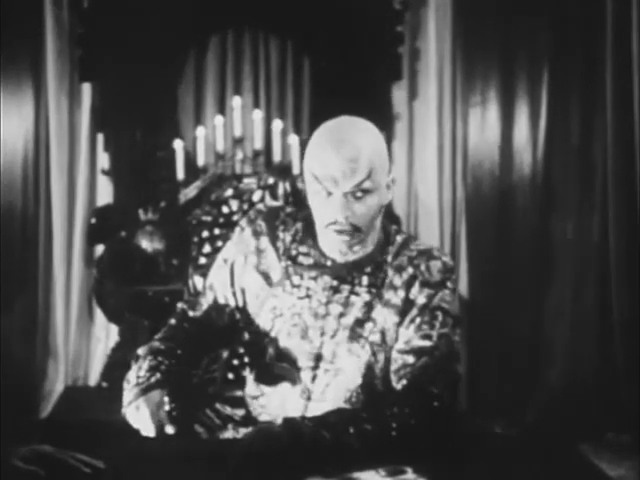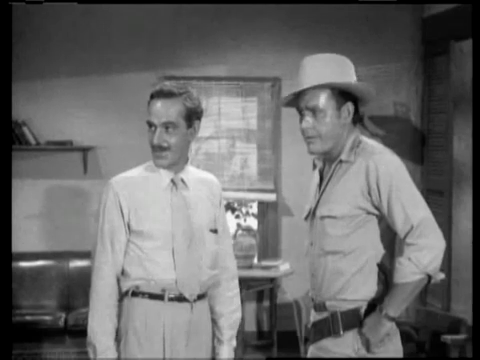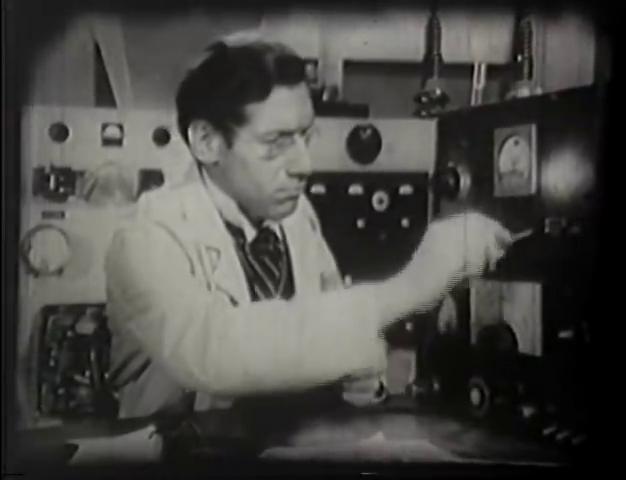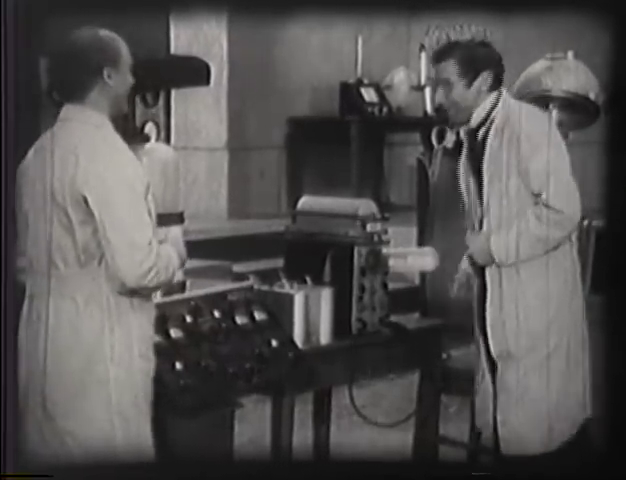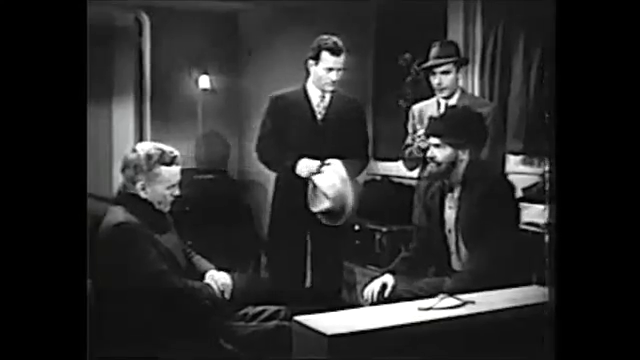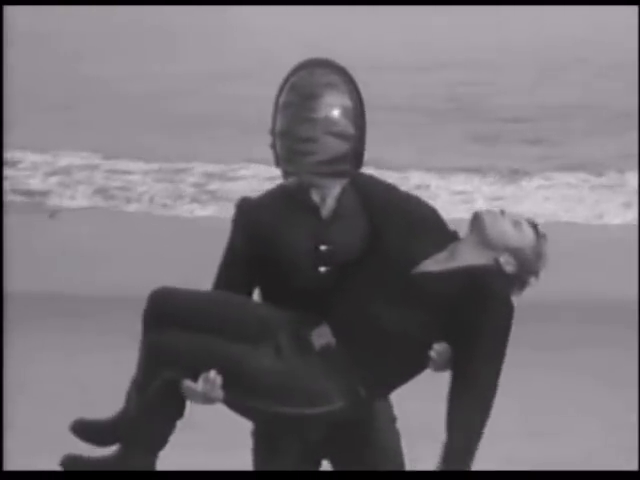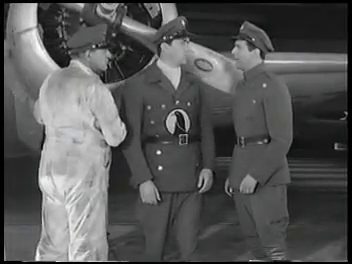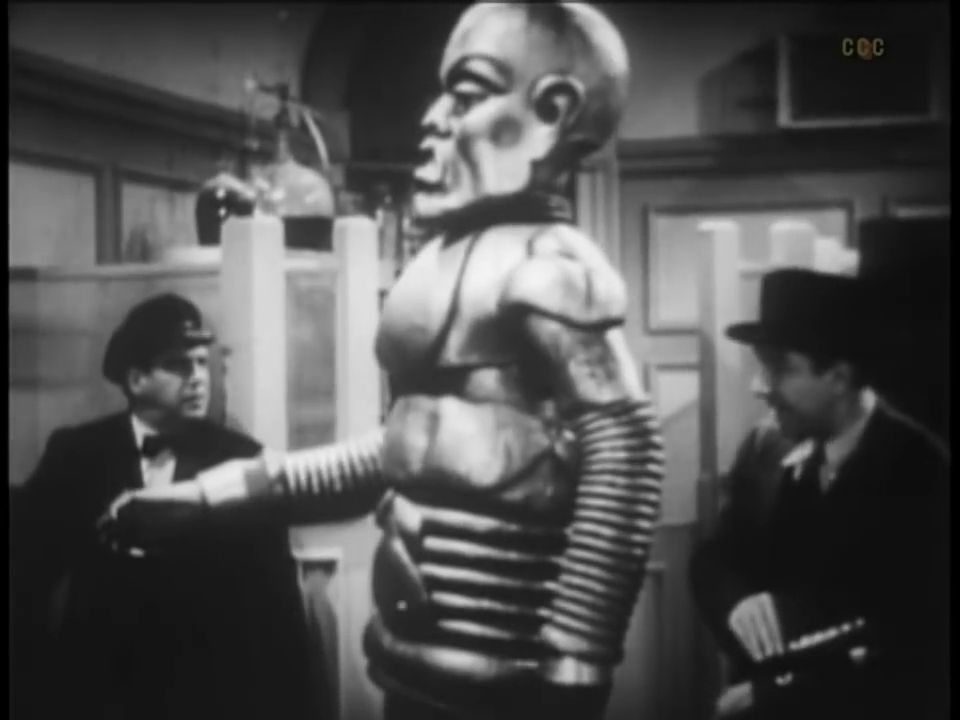-
#471 – King of the Carnival (1955)
King of the Carnival (1955)
Film review #471
Director: Franklin Adreon
SYNOPSIS: A counterfeiting operation to flood the United States with fake money leads to treasury agents Art Kerr and Jim Haynes to investigate a circus in connection with the operation. Art asks acrobat Bert King to aid them in putting a stop to the counterfeiting, and to unmask the villain responsible…
THOUGHTS/ANALYSIS: King of the Carnival is a 1955 film serial and the last serial made by Republic Pictures. As the other two serial producing companies (Universal and Columbia) has already stopped producing them, King of the Carnival stands as the final serial, and the end of the format as a whole. The serial is set in a circus, where Bert King performs as an acrobat (The title “King” of the carnival refers to Bert, and is something that Republic Pictures also did with the lead character in King of the Royal Mounted). When agents of the U.S. treasury Art Kerr and Jim Haynes arrive on the scene investigating a counterfeit operation they believe is connected to the circus, Art asks his old friend Bert to aid them in unravelling the sinister plot. The villain’s plot centres around the production of counterfeit money and flooding the U.S. with it, so that the currency is devalued and other countries lose confidence in it. If that sounds like a dull and boring set-up, that’s because it is. There’s nothing else to this story other than this bizarre plot that doesn’t really make sense: surely it would take a huge operation to destroy a currency like the U.S. dollar, and the serial just has one guy working in a sunken boat. Such an intangible plot never connects with the viewers, and will be sure to bore. The plot does have this similar theme of many post-war serials, in that foreign powers attempt to sabotage the U.S. in some way, marking the onset of the cold war. However, the serial format never returned to it’s peak popularity like it had during the war. The circus element of the story is a bit more unique, but a lot of the action scenes are footage taken from the earlier serial Daredevils of the Red Circle, which wasn’t too great itself.
The characters are a typical and uninteresting bunch. You have the male leads, a single female character who is also an acrobat at the circle (although you never see her doing any of the stunts because the footage taken from Daredevils of the Red Circle had no female performers). The villain “Zorn” has no real presence and just gives orders to his henchmen to do the dirty work. It is revealed that someone at the circus is actually the leader of the counterfeiting operation, setting up a mystery villain reveal at the end, but you probably won’t care as it makes no real difference to the plot.
When this serial was released in 1955, the world of cinema and media in general had moved on from the fifteen or twenty years before when the serial was so popular. However, King of the Carnival could easily have been made at the height of the format’s popularity, and still be pretty poor. It takes no advantages of any advances in technology and the evolution of cinema, and just ends up being another cut-and-paste job that many of the serials are. At this time too, obviously televisions were appearing in people’s homes, and the idea of going to the theatre every week to watch a new instalment was fast becoming outdated when you could just tune in to an ongoing series from your television at home. The serial format never really tried to change or adapt to the times; the companies that made them clearly just saw that their time was up, and focused on feature films. Not that I can really blame them, as the introduction of TV made the format redundant. Going back to King of the Carnival, it feels very much like a poor production that is well aware of it’s fate. The ‘circus’ is clearly just a set with cloths draped all over them to give the illusion if it being a big tent, and the cliffhangers lack any form of imagination or suspense, especially when viewers had been seeing these same ones for over twenty years. Overall, King of the Carnival is a poor swansong for the serial format, accentuating their worst elements such as low budget, repetition, and one-dimensional characters, while not providing any imaginative settings, devices etc. that some of the more popular serials did. The serial format had very much run its course, perhaps many years before King of the Carnival was released, and it is a stark reminder of all of it’s worst elements.
-
#469 – The Master Key (1945)
The Master Key (1945)
Film review #469
Directors: Lewis D. Collins, Ray Taylor
SYNOPSIS: A secret Nazi organisation operating in the United States has kidnapped Professor Henderson in order to force him to finish his “auratron” invention that can make gold out of seawater, and use the gold to fund the Nazis operations. Tom Brant, an FBI agent, hunts down the Nazi spy ring with the help of Detective Jack Ryan and his contacts in the police force to find Professor Henderson and bring the Nazis to justice.
THOUGHTS/ANALYSIS: The Master Key is a 1945 serial released by Republic Pictures and comprised of thirteen chapters. The serial centres around a Nazi spy ring operating in the United States, who kidnap Professor Henderson and force him to complete his “auratron” invention, which can turn seawater into gold, which the Nazis will then use to disrupt America’s industrial might. The only thing standing in the way of their evil plans is FBI agent Tom Brant and his companions in the police department. The plot centres around this Nazi spy ring who identify themselves with a key that has the letter “M” and a number engraved on it. They are given their orders by the “Master Key,” who conceals their identity from even the group. That’s all the “Master Key” of the title refers to, and yes, it’s a rather uninteresting premise, given the keys serve no purpose other than to identify the spies, and are used at the start of each chapter to “summon” the master key who explains the plot. The main focus of the plot is Henderson’s invention which apparently turns seawater into gold, an idea which is sounds ridiculous even by the serial format’s standards. The chapters involve the typical plot structure of the heroes trying to rescue the professor and his invention…the amount of serials that enact this same plot is too many to count, and most of them do it better than this one. The plot has very little direction otherwise, and the back-and-forth between the protagonists and antagonists is painfully slow, and explained through long scenes of exposition that slow the pacing down to a crawl. There’s some cliffhangers that incorporate more impressive large crashes or explosions, but they are usually, and obviously, stock footage or models, and the fallout is never really shown, only explained further with the shot of a newspaper front page and even more dialogue.
The characters are the usual bunch you associate with the serial format: there’s the young male leads who get into the fights, the older men who serve as support, and some token women who get the role of journalist or secretary. The villains likewise are uninteresting and have no character or role other than being henchman. The main villain we never see until the very end, instead giving orders through some sort of radio…thing. There’s constantly very little for the viewer to grasp a hold of, and as such, it is difficult to maintain attention on the serial as a whole. There’s some supporting characters including a bunch of younger street-wise teenagers who help out under the watch of Aggie, a similarly street-wise woman. Again, none of the characters really stand out or do anything of merit.
Released in April 1945, The Master Key was released in the very dying days of World War II. As such, it is difficult to see how relevant the whole Nazi spy ring plot was. The wartime serials typically focused on Japan as the primary U.S. enemy, and choosing the Nazis as the villains is perhaps an odd choice at this time. Each chapter opens up with a disclaimer of sorts saying that the serial is fiction that “could never happen,” and states that it takes place in 1938 before the war even started. I assume this was in order to keep the serial in line with the requires of the regulatory bodies, perhaps setting it before the war was necessary to not give the illusion that the Nazis were still a threat to the US in the then dying-days of the war, and that the U.S. was too powerful for something like this to happen anyway. It’s interesting then that they allowed it during wartime: perhaps they needed people to be on their guard, but on the verge of the Nazis being defeated, the tone changed to saying that there was no way that anything like this could ever happen to America. It’s also interesting that the serial clearly identifies the enemies as Nazis and shows their flags in their hideout: again, most serials previously did not mention the Nazis by name or show any of their insignia, instead showing enemies that were working for a “foreign power” which obviously was meant to be the Nazis. Again I assume the requirements of the film regulators changed at the end of the war, and by being able to identify them and place them in the past, it signified that they were a product of history, and no longer a real threat. Also a small note concerning the invention that can apparently turn seawater into gold: it’s so outlandish and nonsensical even by serial standards that it’s very hard to take seriously.
Overall, The Master Key is a poor showing, released at the wrong time. It has very little direction in terms of story or characters, and the long-winded scenes of dialogue and exposition overshadow any action scenes. It exists at a strange point in history where the Nazis were no longer credible or interesting villains, but also before the post-war serials, which turned either to America’s military war heroes battling foreign spies (implied to be the soviet union) or more sci-fi adventures. As such, The Master Key falls between the cracks and fails to find very little relevancy or entertainment value.
-
#468 – Drums of Fu Manchu (1940)
Drums of Fu Manchu (1940)
Film review #468
Directors: William Witney, John English
SYNOPSIS: Villain Fu Manchu intends to locate the sceptre of Genghis Khan, and use its ancient powers to conquer all of Asia. When his Father is killed by Fu Manchu in pursuit of the sceptre, Allan Parker teams up with Sir Dennis Nayland Smith and his assistant Dr. Flinders Petrie, who have fought Fu Manchu in the past. Teaming up with the British army stationed in Asia, they hurry to find the sceptre and Genghis Khan’s tomb before Fu Manchu can do the same…
THOUGHTS/ANALYSIS: Drums of Fu Manchu is a 1940 serial by Republic Pictures comprised of fifteen chapters, and based on the series of novels by Sax Rohmer (Drums of Fu Manchu is the ninth novel in the series, but the serial borrows plot points from the whole series). The serial starts out with Fu Manchu outlining his evil plans to conquer Asia, using the power of the sceptre of Genghis Khan. In order to track it down, he leaves a trail of death and destruction in his wake as he tracks down the clues to his location. Allan Parker is caught up in Fu Manchu’s schemes as his Father is killed by Manchu’s henchman, and looking to get revenge, Allan teams up with Sir Dennis Nayland Smith, Fu Manchu’s old adversary. The plot of the fifteen chapters unfolds in typical serial fashion, as each chapter inches the plot forward as the heroes and villains engage in a back-and-forth of schemes and counter-schemes to try and outdo each other. Where the serial stands out is its varied settings and action sequences, which are fairly well thought out and keep things interesting. The serial borrowing the best bits from the series of novels probably helped in generating ideas for the fifteen chapters. There is, however, a fair amount of repetition in the serial, particularly in the fact that a lot of the plot is driven forward by one side overhearing the other’s plans, and a counter-scheme being devised. It’s a bit predictable, but that’s very much a staple of the format. The serial does fortunately have a very definite sense of direction, and each chapter edges the plot forward a little towards a goal that is defined from the outset, and simple enough to follow.
The characters are all fairly standard for a serial, with Allan Parker being the typical action-based male lead who does all the stunts and fistfights. Nayland Smith is the protagonist of the novels, but takes a supporting role here, as these serials always require a more action-based lead. The usual lack of female characters are also featured in the serial, with Mary Randolph being the sole female lead who appears very infrequently and provides no contribution to anything other than being the daughter of another more important character. There’s also Fu Manchu’s daughter who plays a role as a minor villain. Obviously the most interesting character is Fu Manchu himself, a villain that has become somewhat cultural icon…for better or worse. His iconic image is fairly recognisable, and he has been the focus of quite a few movies across the decades, meaning his image has become this recognisable figure. As you might expect however, this image is mired in controversy, and has cemented a specific image of “orientalism” in the west for many years (obviously Fu Manchu wasn’t the first character to do this, but his is one of the most enduring). He is played, as most southeastern Asian characters are, by a white man in make-up to “look” Chinese. His attitudes and actions also accentuate a “foreignness” that portrays a difference and opposition to western values. He is definitely one of the more interesting villains seen in a serial, but it relies on some very problematic depictions.
Drums of Fu Manchu is regarded as one of the best serials that was produced, and it easy to see why: the action sequences are varied and intense, and there’s a lot of effort put into the serial in all of its aspects. A lot of consideration is put into depicting Fu Manchu as evil, particularly in the harsh lighting shots that create shadows across his face and give him a very malicious look. A rather unique aspect of this film is the ending, in which Fu Manchu actually survives and escapes the plunge to his doom, promising revenge. It was actually against the film regulator’s guidelines to have film villains survive at the end, presumably as it was morally important to show villains getting justice for their crimes (even if that justice is being hurled off a cliff…). Apparently, an exception was made because the novels had Fu Manchu escaping at the end, and also that the series very much had the potential for a sequel in which Fu Manchu could ultimately meet his end. I think there definitely would have been a sequel, but apparently the U.S. state department put a stop to it because the Chinese ambassador to the U.S. had formally complained about the depiction of Chinese people, and China was also an ally in World War II against the Japanese. This is also probably why the villains in wartime serials were typically Japanese from that time forward. Overall, Drums of Fu Manchu is a good example of the serial format, but comes with a big caveat in its problematic depictions of Chinese people and Asian cultures. The plot has direction, the action sequences are varied and well executed, and there’s generally a good amount of consideration and effort in most of the film’s production. It is easy to see why it is one of the strongest examples of the serial format, although as with the rest of them, it suffers from a fair amount of repetition.
-
#467 – Panther Girl of the Kongo (1955)
Panther Girl of the Kongo (1955)
Film review #467
Director: Franklin Adreon
SYNOPSIS: Jean Evans, a member of a wildlife foundation, is in Africa taking photos of local wildlife when she encounters a giant crayfish that nearly kills her. She teams up with Larry Sanders, a big game hunter, to stop the creature and discover it’s origins.
THOUGHTS/ANALYSIS: Panther Girl of the Kongo is a 1955 serial produced by Republic Pictures and comprised of twelve chapters. The serial centres around Jean Evans, who works for a wildlife foundation taking photographs of wildlife. She is known as “Panther girl” because…I don’t know, she rides an elephant sometimes and dives off cliffs; the only panther I recall seeing is at the end screen. Anyway, she encounters a giant crayfish that attacks her, but is saved by Larry Sanders, a big game hunter in the area. The two team up to try to stop the monster and unravel the mystery of it’s origins, while trying to stop two outlaws in the area. This is the cornerstone of the plot, alongside Dr. Morgan, a scientist also in the area, has created the giant monster to scare off people from a mine full of diamonds while he harvests them all. Obviously, this type of plot has been done to death, and is perhaps more famously associated with a vast chunk of episodes of Scooby-Doo, meaning it’s hardly an interesting watch nowadays when it’s been done and done again. There’s also not much of a plot besides this, and the heroes trying to stop the giant crayfish monster thing. Trouble is, it doesn’t show up for a good chunk of the serial, and so Jean and Larry are left to do the typical back-and-forth with Morgan’s henchman, as they make plans, set traps, and start fistfights with each other. As it is, the plot rarely has any direction, and the stakes are also pretty low, since again it’s not all for world domination or anything, just a man wanting to mine some diamonds in the middle of nowhere.
Quite rarely for a serial, the main character is a woman. Jean Evans is the “panther girl” due to her prowess in the jungle (even though there’s no panthers that we see), and she actually does something other than being kidnapped. The only other serial that does this to this degree is perhaps Jungle Girl (more on that later). However, when the script requires it, she does revert to the typical screaming damsel in distress, and the male lead swoops in to save her. He also does most of the shooting and punching, but still Jean’s character is central to the plot. Larry is just a typical male lead with no real character. The villains also are just typical henchman and a “mad” scientist who isn’t all that mad, just wants to get rich. The setting of non descript “Africa” and its stereotypical depiction of “tribes” is problematic and presenting the entire continent in this way is a depiction that prevailed for decades thanks to films such as these.
The serial is quite similar to the Jungle Girl serial released in 1941, particularly with regards to a jungle-savvy female lead. This is also not coincidental, as this serial uses a lot of the footage from the serial, particularly the on-location stuff and animals. In 1955, the serial format was really on it’s last legs, and it’s no surprise that the studios wanted to do as little new stuff as possible (although cost-cutting and re-using footage has been a staple of the serial format for years at this point). Since Jungle Girl was released fourteen years before, and theatre-goers probably wouldn’t have seen it or forgotten about it due to the lack of home media releases, and the only way to see older serials would be to watch re-releases at theatres, which I believe were somewhat rare, and even then they really don’t benefit from repeated viewings. The re-used footage is pretty heavy in the finale, when the action sequences are almost entirely made up from this footage, and the transition between the different footage is very awkward and disjointed. For example, you can clearly see “Jean’s” outfit change from scenes as she instantly switches from a miniskirt to swinging from the trees in leggings. The “giant” crayfish is obviously not a giant one, just a regular one filmed amongst miniatures. It’s not particularly convincing, especially when the “giant claw” attacks people with the rest of its body just offscreen. Overall, Panther Girl of the Kongo is a fairly weak serial, in which it’s most interesting aspects are just bits of re-used footage. The plot is non-directional and has fairly low stakes, alongside often feeling it’s just padding for the more interesting re-used footage. The emphasis on the female lead is a more unique aspect, but she is reverted to the typical “damsel in distress” when the plot wants to do a more typical set-up of the female being the victim. The serial is very low on imagination and spectacle, and is emblematic of the serial format in it’s twilight years as the format became unviable with the introduction of televisions in homes.
-
#466 – The Lost Planet (1953)
The Lost Planet (1953)
Film review #466
Director: Spencer Gordon Bennet
SYNOPSIS: Investigating a suspected U.F.O. crash in the mountains, reporter Rex Barrow and photographer Tim Johnson head there to check it out, but find themselves captured and sent to the planet Ergro by scientist Dr. Grood, who sends them to work on the planet to mine minerals and build his inventions to take over the universe. Rex, Tim, captured scientist Professor Dorn and his daughter Ella must overcome Grood’s mind control device and other contraptions as they try to put a stop to his evil plans…
THOUGHTS/ANALYSIS: The Lost Planet is a 1953 serial produced by Columbia Pictures and comprised of fifteen chapters. It is the last science-fiction serial that the studio produced (although the studio itself only produced three serials which could be fully described as “science-fiction”). The serial starts out with reports of a flying saucer crashing on Mount Vulcan, and reporter Rex Barrow and photographer Tim Johnson go to investigate, but end up getting captured along with Ella Dorn, and taken by rocket ship to the planet Ergro, where evil scientist Dr. Grood has taken over the planet to mine a new element that fuels his evil inventions. The plot of the serial revolves around trying to stop Grood and his various inventions, most notably his mind control device, which places prisoners in his power. It’s not only that though: this element that Grood is mining also fuels inventions such as a death ray, mind-reading device, invisibility and a whole host of other sci-fi tropes. Normally just one of these inventions would be enough for a serial to focus on, but here they’re all thrown into the mix. While this helps with keeping the serial varied across its fifteen chapters, it also has the effect of having little focus on any one of them. The one which stands out most is the use of the mind-control/hypnosis device. which is probably the least interesting of them all, and a lot of the plot just revolves around being hypnotised and de-hypnotising certain characters, creating a predictable back-and-forth.
One of the interesting aspects of this serial is that it seems to have been planned to be a sequel to the Captain Video serial. A lot of the same actors return, and the costumes and props are obviously re-used from it (for example, the outfits of the “video rangers” are used for the uniforms of the brainwashed people on Ergro). Whether the idea of making this a sequel was scrapped early on for some reason is anybody’s guess. The characters themselves are an unassuming bunch, and fit the typical parts that these serials provide. Unlike Captain Video though, this serial actually has a female character, although as usual, her only noteworthy aspect is being related to another more important male character. There’s a number of villains that have their own unique personalities and play off against one another, but it never really develops into something remarkable, and the web of villains just becomes confusing and muddled. Particularly as the serial switches between Earth and Ergro constantly.
In terms of production, there’s some decent sets in this serial. The rocket ship looks good, and the space travel sequences between Earth and Ergro look pretty good, considering in 1953 no one had ever been into space. The acting is not great, but there’s definitely worse performances I’ve seen in serials. It might have gotten away with it, but some of the dialogue is pretty dull and loaded with technical jargon that the actors seem to be convinced about saying. One other problem is that both Earth and Ergro look exactly the same; obviously because both are filmed in the California hills like every other serial, and as such this adds to the confusion surrounding the story, as both planets look so alike you don’t know where you are some of the time. Another curious decision about the making of the serial is that there’s none of the typical fistfights you get in nearly every serial: the only time someone throws a punch is when Rex is turned invisible, and so even then, you can’t see him actually throw the punch. This is incredibly strange, most notable because Spencer Gordon bennet, the director, practically invented the choreography for serial fistfights. Maybe they wanted to focus on the scientific inventions and their varied effects for the action, but even then, as mentioned, this is only the third sci-fi serial Columbia made, and it seems a bit out of their comfort zones.
Overall, The Lost Planet is a bit of a mess, and suffers from attempting to do too much. The inventions and sets are cool, but they’re all just props without a decent plot to coalesce around. The stakes are pretty detached as most of the action unfolds on this non-descript planet, and the characters fail to make an impact despite having such a large cast. The lack of action in this serial is very questionable, and the array of inventions don’t really fill in the gap. The whole serial is full of typical set-ups and schemes, but fails to give any motivation for the characters, or direction for a plot to develop.
-
#464 – The Great Alaskan Mystery (1944)
The Great Alaskan Mystery (1944)
Film review #464
Directors: Lewis D. Collins, Ray Taylor
SYNOPSIS: Dr. Miller, along with Dr. Hauss, has invented a new death ray called the paratron. However, Dr. Hauss is secretly a Nazi spy, who intends to steal the death ray to give to his home country. Jim Hudson, an adventurer of sorts, tells Miller that the material he needs to complete the paratron may be found in the Alaskan mines, and so they set off there, only to have their plane crash on the way…
THOUGHTS/ANALYSIS: The Great Alaskan Mystery is a 1944 serial released by Universal pictures comprised of thirteen chapters. The serial centres around the invention of a death ray called the “paratron,” invented by Dr. Hauss and Dr. Miller. However, they are having trouble completing it. Jim Anderson, an adventurer who knows Dr. Miller’s daughter Ruth, visits and remarks that a rare mineral that can be found in mines in Alaska might be what they are looking for. They all set out on a boat to Alaska, but various machinations are at work, as Dr. Hauss is secretly a Nazi spy, and intends to steal the paratron for his own country, getting the Captain of the ship to aid him in his scheme. The ship sinks and the cast are forced to survive in the Alaskan wilderness until they are rescued. The first two or three episodes are quite varied and dump the cast straight into the Alaskan wilderness doing what you would expect them to di in Alaska: getting caught in the snow, visiting Inuit natives, and such. After chapter three, the serial settles down into a more typical format, with the heroes and villains engaging in a back and forth as they try to get a hold of the paratron and stop each other. In terms of story then, it’s a standard serial affair. The stakes aren’t particularly high as everything revolves around this death ray which while is indeed powerful, doesn’t seem as revolutionary as some other inventions used in these serials (maybe because the idea of the death ray has been done to death). Also this is a wartime serial, and the stakes here probably pale in comparison to the real war going on at the time. There’s also perhaps something to be said for the fact that the setting of Alaska makes the serial feel somewhat removed from any wider context. However, the serial does make good use of the Alaska setting, as we get a decent amount of shots of the wilderness and unique set-ups in the mountains and snow, even if they rely heavily on stock footage.
The cast for this serial is fairly large. However, none of them really stand out, and fall into very typical serial roles. The cast does however, consist of a number of popular and well-known actors of the time, which enhances the serial with some decent performances. You have the typical protagonist, the sole female character, and the elderly scientist, along with the villains and their henchman. There’s also plenty of characters pretending to be helping the heroes when they are the villains. it all adds up to quite a mystery, but never really flows into a coherent experience as all the characters are easy to get mixed up and don’t form their own unique performance.
As mentioned, the depictions of Alaska are perhaps the most unique part of the serial, with plenty of scenic shots, lumberjacking, and wilderness sets that make it look the part. The dialogue is what mainly drives the story though, as with most Universal serials. There’s not a lot of action scenes outside of some classic shoot-outs and chase scenes, and again that is typical of a Universal serial, which usually are less action-oriented than the ones from rival serial producer Republic. Overall, The Great Alaskan Mystery has many of the serials tropes that it needs to, but fails to bring it’s busy story and large cast together to create anything special. It’s got everything it needs, but is ultimately a bit forgettable, leaving it to be remembered as just another average serial amongst the many of the format.
-
#462 – Mysterious Island (1951)
Mysterious Island (1951)
Film review #462
Director: Spencer Gordon Bennet
SYNOPSIS: A group of soldiers fighting in the American civil war are captured by Confederate forces. They eventually escape on an observation balloon, but find themselves drifting for days, eventually landing on a desert island far from civilisation. However, the island is far from deserted, as a native tribe, pirates, aliens, a castaway, and a mysterious masked man are all up to various schemes on the island, and the new arrivals must find a way to survive against all these different factions and find a way home…
THOUGHTS/ANALYSIS: Mysterious Island is a 1951 science-fiction serial comprised of fifteen chapters. It is based on the novel of the same name by Jules Verne. The serial is set in the year 1865, during the American civil war, where during the siege of Richmond, Virginia, Captain Cyrus Harding is captured by Confederate forces and taken prisoner. he engineers an escape with some other prisoners by hijacking an observation balloon. Unfortunately, a storm sweeps the balloon way off course, leaving it to drift for many days. When it lands, the crew find themselves on a desert island far from any civilisation, with no way home. They quickly find that the island is far from deserted however, and the new arrivals must contend with multiple factions and their schemes. As mentioned, the serial is based on Jules Verne’s novel of the same name, and incorporates a fair amount of the novel’s structure and characters. This is in contrast to a lot of serial adaptations of comics and books, in which usually only one or two main characters are made to fit into the serial format, omitting a lot of the original’s world and set-ups (such as things that would be too expensive to implement). As such, the serial has a good flow and pacing that keeps things interesting across the fifteen chapters. There’s still plenty of tried serial tropes when characters set up elaborate deaths with plenty of opportunity to escape rather than just killing them, but on the whole there’s plenty going on between all of the different factions to keep things varied and interesting. Even through the fifteen chapters, which is at the longer runtime of these serials, it keeps things consistently entertaining.
Let’s talk about the characters in this serial: there is a very large cast, and multiple different factions that are working against each other. Apart from the main cast that wind up on the island, there’s the native population, a castaway that has gone mad, pirates, aliens from the planet Mercury, and a mysterious masked man. In keeping with the novel, all of these characters are from the source material apart from the aliens from Mercury, which were added for the serial. The serial could have easily got away with not adding them, as there’s plenty of characters and plot anyway, but I suppose they were added to keep up with trends, as sci-fi serials and films started to get more popular after World War II had ended and the subsequent years in which war heroes were the protagonists of choice. The alien characters and plot fit in fairly well and are incorporated into the story so that they don’t stick out as a forced inclusion, which is good. While none of the characters are really unique or memorable, they have a consistency in their acting, and you know who they are and who they’re aligned with when they’re on screen. The heroes are perhaps the least interesting bunch, as they’re all typical young male leads without any special talent or occupation. Nevertheless, you will be on their side as they try and make their way home.
Mysterious Island is a nice surprise in the period of the serial format’s declining popularity. Obviously helped by being based off a famous novel helps give the story an interesting set of characters and set-ups, the serial also incorporates its own elements which, while nothing unique, is integrated nicely with the rest of the source material, even if the sound of pirates, American Civil War, and aliens together sounds like an absurd mix. The acting is decent, the sets convey a consistent sense of location, and the story has a good sense of direction that maintains interest and excitement. Spencer Gordon bennet, the director, was a serial veteran by this point, and delivers his usual developed choreography in fight scenes and keeping the pace of the serial steady yet energetic. Overall, Mysterious Island is a surprisingly decent addition to the serial format, at a time when good examples of it were few and far between.
-
#460 – Spy Smasher (1942)
Spy Smasher (1942)
Film review #460
Director: William Witney
SYNOPSIS: The masked hero “Spy Smasher” is captured in Paris on a secret mission to obtain plans for sabotage operations in the United States. He escapes back to his home country, where he is reunited with his brother Jack. However, the Nazis have also made their way to America shores, and the two team up with intelligence officer Admiral Corby to counter the threat…
THOUGHTS/ANALYSIS: Spy Smasher is a 1942 movie serial comprised of twelve chapters. It is based on the comic book series of the same name. The serial opens up in Paris, where the eponymous masked hero “Spy Smasher” is on a secret mission to obtain plans for a sabotage operation to be carried out in the United States. He is, however, captured, and after unsuccessful torture attempts, he is sentenced to death in front of a firing squad. Fortunately, a member of the French resistance, Pierre Durand, fakes his death, and is able to smuggle him back to the United States. The opening of this serial is quite uncharacteristically dark compared to others of the genre: The scenes of torture (implied, but shown just offscreen), and the firing squads are perhaps a more authentic look at what was happening during WWII at the time than other serials portrayed. From the outset, the serial feels a little more grown up than others, which is odd considering they were mostly aimed at younger viewers. Back in the United States, the Nazis have snuck in and are on a train to carry out their plans, when one of them recognises Spy Smasher and attacks him. It turns out that it is not Spy Smasher at all, but his brother Jack, and Alan (who is Spy Smasher in disguise) defeats the Nazis and reveals himself to his brother. The two team up with navy intelligence officer Admiral Corby and his daughter Eve (Jack’s fiancée) to counter the Nazi threat that Alan/Spy Smasher helped to expose. The rest of the serial’s story is simple enough to follow, but there’s a lot of different locations, such as Spy Smasher returning to Paris to free Pierre from the Nazis, which helps keeps things varied and interesting. The variety slows down in the latter half of the serial, but the finale has plenty of action and consequences to make it pretty enjoyable.
The characters are (as always) a familiar bunch insofar as they all follow very specific tropes that form the backbone of the serial format’s character roster. Jack and Alan are the typical young male stars that do all the action sequences and punch plenty of Nazis in the face. Admiral Corby is a typical older man that serves as the boss who receives intelligence and gives instructions. His daughter is the token female, who serves the typical role of simply being a family relation to a male character. It’s a pretty small cast, but it means that more time is focused on the actions of Spy Smasher, which is what you want to see really. The villains are Nazis. That’s it. They are mostly in their full uniforms somewhat faithfully recreated, whereas a lot of serials simply imply that the villains are Nazis, or working for a “foreign country.” The villains are led by a masked individual known unsurprisingly as “The Mask.” Despite the fairly decent costumes on the villains, the mask for The Mask is literally a piece of white cloth covering his face with some holes cut out for the eyes. I’m not sure why they bothered, since his identity isn’t of any importance, and he routinely removes it when communicating to certain people. The mask is apparently the villain from the comics, so I suppose he was just added to tie in with the comic, but he doesn’t stand out as a unique villain.
The production values are pretty good for a serial, and although there’s no exotic or novel sets, what we do get is sturdy and has a decent scale. The action scenes on top of speeding trains and the like are also well done, and deliver a good sense of danger. As mentioned the costumes are pretty good as well…apart from The Mask’s “mask” anyway. There’s also some plots involving planes and ray guns, which again add to the variety. Overall, Spy Smasher is a serial that stands above the average in terms of quality in the genre, thanks to it’s variety in the story and its grounded, consistent logic, alongside some good production values and camerawork. It’s a very good example of the wartime serials that portrayed the Nazis as the villains, without the film being simply propaganda. All in all, worth your attention if you’re a serial fan.
-
#458 – Blackhawk (1952)
Blackhawk (1952)
Film review #458
Directors: Spencer Bennet, Fred F. Sears
SYNOPSIS: The elite group of air pilots, The International Brotherhood, led by the heroic Blackhawk thwart threats to the country without the use of weapons. They are tasked with stopping a foreign spy and her various schemes, leading to a series of daring adventures.
THOUGHTS/ANALYSIS: Blackhawk is a 1952 serial comprised of fifteen chapters, based on the comic series of the same name. The action centres around the group of air pilots called The International Brotherhood, a group of former WWII pilots led by the heroic Blackhawk. They are assigned the task of bringing down a foreign spy named Laska, who is working for a mysterious Leader. The story revolves around Blackhawk and his boys foiling Laska’s plots which are fairly varied throughout the fifteen chapters. There’s no real overall plot other than just stopping Laska; there’s some smaller plots concerning death rays and recovering new energy sources which would be the full plot to some other serials, but this one condenses each of these plots into two or three chapters, which keeps things somewhat varied and interesting, as some serials that hinge around just one of them get stale very fast. However, having very little to tie the whole serial together makes it suffer a lack of direction. On the other hand however, it’s just good guys chasing bad guys, and that’s all it needs to be. If you’re watching a serial, you won’t be expecting a complex narrative, and they’re mostly for younger viewers as well, so they just want to see the good guys fight the bad guys, and on that point the serial has enough action to make it interesting enough. You also have three or so chapters in Mexico in a more self-contained story, which would have been an optional part for cinemas to purchase depending on whether they bought either the twelve chapter or fifteen chapter version of the serial (a fairly standard practice at the time).
The heroes are a group of former WWII air pilots that work together to take down foreign enemies in their planes. They also make a point that they don’t use guns or weapons, but never explain why. Perhaps it’s something they did in the comics. The head of these pilots is Blackhawk, who is a very typical protagonist, being the young-ish, stocky man who gets to throw plenty of punches. The rest of his team don’t have much character themselves, and just serve as an extra pair of hands for piloting planes and throwing fists in a fight. The villains are also fairly forgettable, with the usual cast of henchman identified as working for the “Reds,” signifying the shift in America’s enemies after WWII. Laska, who serves as the main villain is played by Carol Forman, who played quite a few similar lead female villains in serials such as The Black Widow and Superman. She knows how to play the role, but her character is never given any motivations or depth, and simply serves as a simple villain. There’s also a mysterious Leader who gives Laska her orders, whose identity is kept secret until the very end. He only appears very sporadically, and his identity has no impact on the story. In fact, I didn’t even recognise his character as it was one that was apparently killed off early in the serial.
Produced in 1952, after both WWII and the peak of the serials, Blackhawk has little to offer the genre. With serial veteran Spencer Gordon Bennet being one of the directors, the fight scenes are decently co-ordinated, and there’s some variety in the shots, but nothing too special. A lot of the climaxes of the chapters seem to end up in factories for whatever reason, but there’s some aerial combat too and the usual vehicles going off cliffs. As mentioned, the serial was released after the peak of the format, so there’s nothing special to write about. Even the spike in the popularity of war heroes as characters in serials that started after WWII was starting to wain in 1952 in favour of looking to the future with science-fiction and the space race. As such, this is the last serial that focused on air combat and planes. Overall, Blackhawk is a pretty standard serial, but fails to offer anything special.
-
#456 – The Phantom Creeps (1939)
The Phantom Creeps (1939)
Film review #456
Directors: Ford Beebe, Saul A. Goodkind
SYNOPSIS: An evil scientist named Dr. Zarko has developed inventions that he intends to use to take over the world. With the government and foreign spies constantly trying to get him to get a hold of his inventions, Zarko is uninterested until his wife his killed, when Zarko swears vengeance against the world. Faking his own death, he adopts a new disguise and sets to work. Bob West, a government agent, works together with Dr. Frank Mallory, Zarko’s once-assistant, and journalist Jean Drew to try to foil Zarko’s various attacks and the spies who want his work, while beginning to suspect Zarko is not dead after all…
THOUGHTS/ANALYSIS: The Phantom Creep is a 1939 film serial composed of twelve chapters. Most notable for featuring film icon Bela Lugosi as the villain, it would also be the last movie serial he would star in. The serial starts off introducing Lugosi’s character Dr. Alex Zarko, a brilliant scientist but a bit eccentric as he likes to play tricks on the government agents and foreign spies that are attempting to buy or steal his inventions. He takes everything in good stride until his wife is killed, and the thought of vengeance on the world completely consumes him, and begins using his inventions for evil after faking his own death. Government agent Bob West teams up with Dr. Frank Mallory, who was Zarko’s assistant who wanted him to donate his inventions to the government for the benefit of mankind, and left when he refused. Also working with Jean Drew, a journalist at a national newspaper. Together, they take on the spies that are attempting to get a hold of Zarko’s inventions, and investigate whether Zarko is really dead. One thing that stands out in this serial is all the various inventions that Zarko uses. He has invisibility, an eight-foot robot, robotic spiders that can paralyze people and also a device to put people into suspended animation. Normally, only one of these inventions would serve as the main plot point for a serial, but this serial gives us all of them. While all of these inventions have been the focus of other serials, having them all together like this gives some much needed variety, as different chapters focus on different things, and are used fairly creatively in the various schemes and set-ups. The plot has a lot of back-and-forth with the characters ending up at Zarko’s old home many times, only to be continually come under attack and being surprised when they do so. The story goes round in circles and lacks some direction with so many different things happening, but it’s better than nothing happening, which is what many serials do when they try to stretch very little over twelve to fifteen chapters.
In terms of characters, they are nothing special: there’s all the usual characters from the young action-hero, the sole female etc., but the star of the serial is obviously Bela Lugosi, who gets first billing, and is always the star of every film he is in. His performance is similar to his usual roles (he is the villain in a few serials), but he undoubtedly draws in the audience for those very roles. He also has an assistant called Monk, who plays the role of the idiotic assistant who bungles and sometimes intentionally sabotages Zorka’s plans provides some comedic value, but is mostly there to give Zorka someone to interact with and get his wrath out on.
With all of the inventions and devices that form the backbone of the action, the effects are fairly well pulled off. Of course, the mechanical spiders and the floating objects being carried by an invisible Zorka aren’t convincing nowadays, but there’s definitely worse I’ve seen in the serials of this time. One thing of interest is that there’s not many fistfights or gun shoot-outs, which is usually what most of the action in serials consist of. This serial has all of the inventions to replace that, but also focuses a little more on setting up large scale explosions or vehicle crashes that form the chapter’s cliffhangers. The chapters are also fairly longer than usual, going to about twenty minutes whereas some serials only have fifteen minute chapters with a lot of reused footage from a previous chapter. As such, I think you would get your value for money going to watch this at the theatre in comparison to others. Overall, The Phantom Creeps has a fair amount to offer viewers with its imaginative inventions, and Lugosi’s star quality. The story lacks direction sometimes and the other characters fall flat due to some dull acting and lack of anything unique about them, but overall the serial has enough to make it an above average venture.



